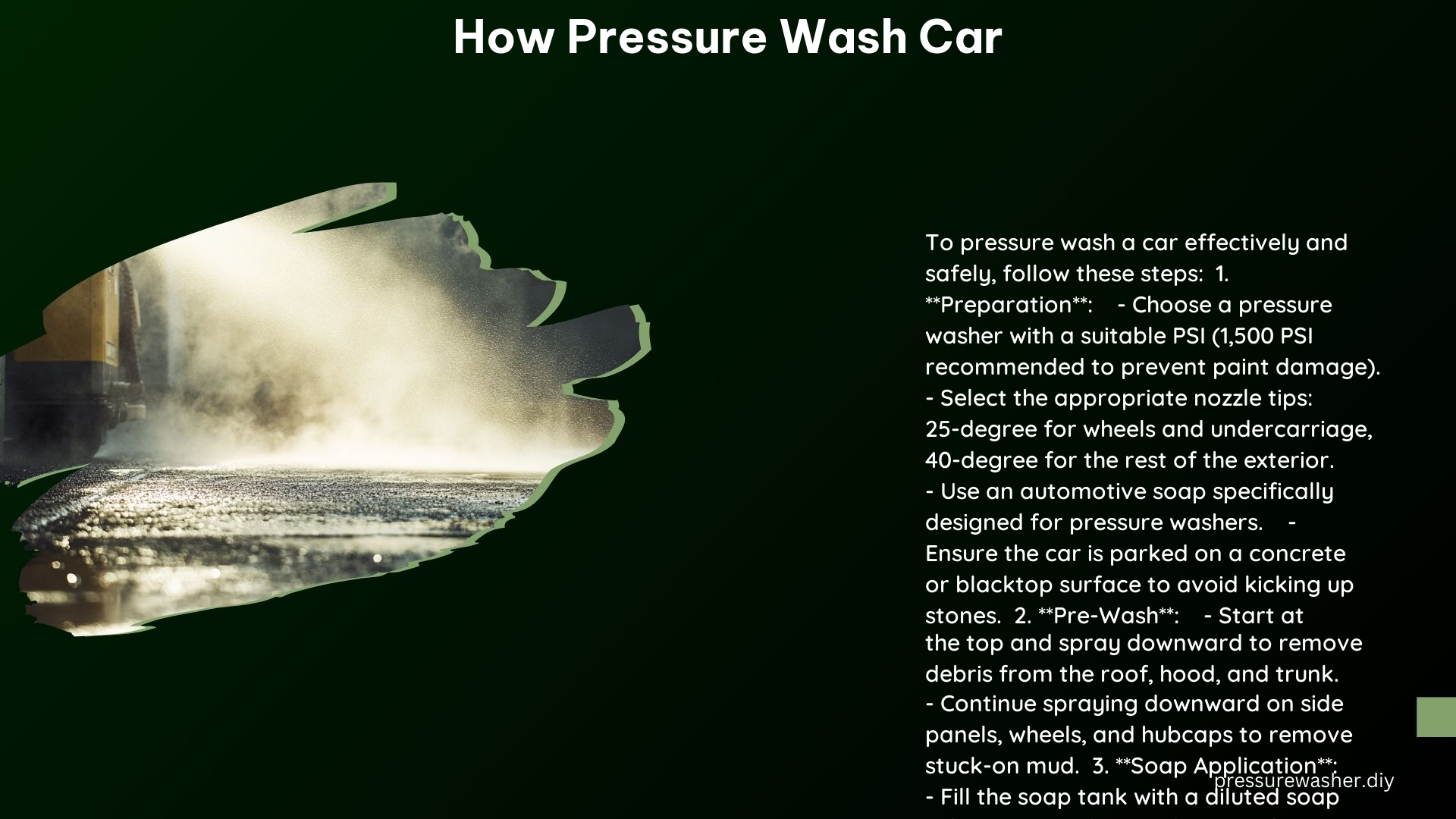Pressure washing a car can be an effective and efficient way to keep your vehicle looking its best. However, it’s crucial to approach the task with caution and the right techniques to avoid damaging the paint or other sensitive components. In this comprehensive guide, we’ll dive deep into the specifics of pressure washing a car, covering everything from choosing the right equipment to executing the process safely and effectively.
Choosing the Right Pressure Washer
The key to successful pressure washing lies in selecting the appropriate equipment for the job. When it comes to pressure washers, the most important factor to consider is the PSI (Pounds per Square Inch) rating. According to Family Handyman, the recommended PSI range for pressure washing a car is between 1,200 and 1,900. Turtle Wax, a leading automotive care brand, suggests using a pressure washer with around 1,500 PSI to prevent potential paint damage.
In addition to the PSI rating, the type of nozzle you use can also have a significant impact on the effectiveness and safety of the pressure washing process. For general cleaning, a 40-degree nozzle is recommended, as it provides a wider spray pattern that is less likely to cause damage. For more targeted areas, such as wheels and wheel wells, a 25-degree nozzle can be used to provide a more concentrated and effective cleaning.
Preparing the Car for Pressure Washing

Before you begin the pressure washing process, it’s essential to properly prepare the car to ensure the best possible results and minimize the risk of damage.
Parking on a Solid Surface
One of the most important steps in preparing the car is to park it on a solid surface, such as concrete or asphalt. Avoid parking on gravel or other loose surfaces, as this can lead to stones or debris being kicked up and potentially scratching the paint.
Rolling Up Windows
Another crucial step is to ensure that all the windows on the car are rolled up before starting the pressure washing process. This will prevent water from entering the interior of the vehicle and potentially causing damage to the electrical components or upholstery.
The Pressure Washing Process
With the right equipment and proper preparation, you can now begin the pressure washing process. Follow these steps to ensure a thorough and safe cleaning:
Start at the Top
Begin the pressure washing process at the top of the car, working your way down. This will allow you to remove debris and dirt from the roof, hood, and trunk, preventing it from being pushed down onto the lower parts of the vehicle.
Apply Soap
Using a soap tank or foam cannon, apply a generous amount of car-specific soap to the surface of the car. Follow the manufacturer’s instructions for the appropriate water-to-soap ratio to ensure optimal cleaning performance.
Rinse Thoroughly
After applying the soap, switch to a water-only setting and thoroughly rinse the car from top to bottom. This step is crucial to remove any remaining dirt, debris, or soap residue, ensuring a clean and streak-free finish.
Additional Tips and Considerations
While the steps outlined above provide a solid foundation for pressure washing a car, there are a few additional tips and considerations to keep in mind:
Avoid Direct Sprays
When pressure washing, be mindful of the front grille and avoid spraying directly into it. This can potentially damage the radiator and other sensitive components behind the grille.
Dry the Car
After the final rinse, be sure to dry the car thoroughly using a microfiber cloth or chamois. This will help prevent the formation of water spots and ensure a streak-free finish.
Alternative Methods
If a pressure washer is not available, there are alternative methods you can use to clean your car effectively. One option is to use a garden hose with an attachment or finger-added pressure to create a similar cleaning effect.
Safety Precautions
Pressure washing a car can be a powerful and effective cleaning method, but it’s essential to take the necessary safety precautions to avoid damage to the vehicle or personal injury.
Maintain a Safe Distance
When pressure washing, it’s recommended to stand at least six feet away from the car to reduce the risk of damaging the paint or other sensitive areas.
Avoid Narrow-Angle Nozzles
As mentioned earlier, it’s crucial to use a 40-degree nozzle for general cleaning. Narrow-angle nozzles, such as a 15-degree or 25-degree nozzle, can be too aggressive and increase the risk of paint damage.
Additional Resources
For more detailed instructions and tips on using a pressure washer to clean your car, consider the following resources:
- Turtle Wax’s guide on how to clean your car with a pressure washer
- Family Handyman’s video on how to pressure wash your car without damaging it
- Tino Car Care’s video providing additional tips and a detailed walkthrough of the pressure washing process
By following the guidelines and recommendations outlined in this comprehensive guide, you can effectively and safely pressure wash your car, keeping it looking its best for years to come.
Reference:
– Turtle Wax Guide on Pressure Washing Cars
– Family Handyman Video on Pressure Washing Cars
– Tino Car Care Video on Pressure Washing Cars
